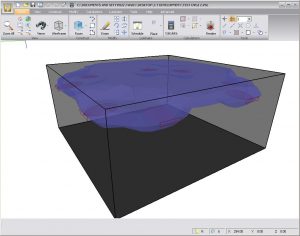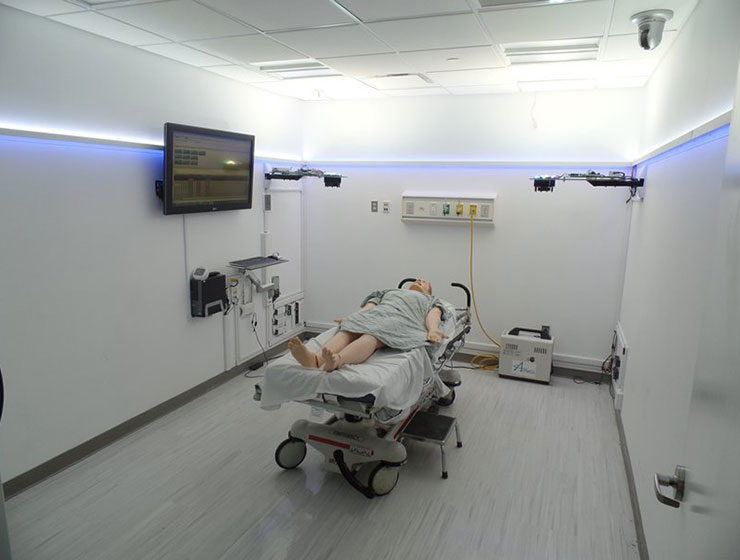International Health Focus
- Global Health Project (NIH Fogarty; fifth year sub-award): Our UVGI program was selected to coordinate and be a technical advisor on a Fogarty-NIH training/stimulus grant as a subcontractor to Brigham and Women’s Hospital and Harvard Chan School of Public Health. The project has hired nine research fellows–five from Africa, one from Peru, and three from the USA–to advance the application of UVGI for control of tuberculosis and other airborne diseases in low-resource countries. Use of upper-room UVGI in hospitals located in countries with high rates of endemic TB has been hindered up to now due to a lack of appropriately designed low-cost fixtures manufactured in-country. As no international standards for upper-room UVGI fixtures exist, units designed in low-resource countries have been poorly characterized and few, if any, match the safety and efficacy of current fixtures manufactured for use in the United States. But high-quality, U.S.-made fixtures are expensive to purchase and install, as well as to operate and maintain, for most hospitals in the developing world. The development of energy-efficient, low-cost upper-room UVGI fixtures for use in developing countries is a primary goal of the Fogarty project. This work is conducted in collaboration with institutions in South Africa, Peru, and the United States. Edward A. Nardell, MD, Brigham and Women’s Hospital, Harvard Medical School is the PI.
 Airborne Infection Control Book (ongoing): Since the inception of the Airborne Infection Control course, the UVGI unit has been represented on faculty. The curriculum concerns building design and engineering approaches to airborne infection control, teaching UVGI lessons learned in the TUSS homeless shelter study, and training attendees on the use of the CAD UVGI tool. Participants are primarily from resource-limited settings with a high rate of MDR-TB and XDR-TB. We seek funds to develop a book on Airborne Infection Control based on this course. Pittsfield Anti-Tuberculosis Association has provided two-year grant support. U.S. CDC provided funding support for this project. Funding is needed to complete the book in time for the tenth iteration of the course in 2018.
Airborne Infection Control Book (ongoing): Since the inception of the Airborne Infection Control course, the UVGI unit has been represented on faculty. The curriculum concerns building design and engineering approaches to airborne infection control, teaching UVGI lessons learned in the TUSS homeless shelter study, and training attendees on the use of the CAD UVGI tool. Participants are primarily from resource-limited settings with a high rate of MDR-TB and XDR-TB. We seek funds to develop a book on Airborne Infection Control based on this course. Pittsfield Anti-Tuberculosis Association has provided two-year grant support. U.S. CDC provided funding support for this project. Funding is needed to complete the book in time for the tenth iteration of the course in 2018.
- Development of International Guidelines for UVGI Application (ongoing): Working with Partners in Health, the University Research Company (URC), TB CARE II, and USAID, we are providing expertise and input on the application of UVGI for airborne disease control in resource-limited settings. The goal is to present a proposal to the World Health Organization for adoption. The first international meeting on UVGI guidelines was held in Bethesda, MD, in 2015. The second international meeting was held in Pretoria, South Africa, in 2016. Both were organized by our research group. Additionally, as a technical advisor to a project in India funded by TB Cares II, the goal of this project is to develop a business model for sustainable UVGI in India working with Lattice Innovation.
- Myanmar TB/UV Clinic Assessments (ongoing): Working with Save the Children, and the U.S. CDC, we conducted 17 site assessments of TB/HIV clinics and hospitals in seven different states. This was the first assessment of facilities in Myanmar to review airborne infection control as a part of the National TB Control Initiative and to make recommendations for UVGI implementation.
- Germicidal UV Measurement and Maintenance Manual (completed): The End Tuberculosis Transmission Initiative (ETT), a working group of the Stop TB Partnership, funded a UVGI maintenance manual which describes the steps to take in order to sustainably maintain and operate UVGI air disinfection systems over time. It is estimated that of the roughly $4 billion in aid grants for foreign countries for various medical equipment, only 4-5% is still operating after the initial installation since there is no ongoing maintenance nor institutional capacity where this equipment is placed. This manual, along with the partnerships being developed by ETT, will help address this need for UVGI.
Hospital Acquired Infections (HAIs)
- Pilot UVC Unit for Decontaminating Mobile Phone (internal; active): Mobile technology used by healthcare workers has the potential to cross-contaminate patients. We are testing a self-contained UVC unit for cleaning cellphones in the ICU and ED of Mount Sinai Hospital. This is being funded by CleanSlate, Limestone Labs.
- Benchmarking UVC robots (internal; active): We have developed a protocol for testing mobile, whole-room UVGI devices as a means to reduce HAIs in unoccupied patient rooms. Some recent reports show that UVGI is an effective surface decontaminant. We plan a laboratory study of efficacy to determine whether or not to conduct a clinic-based study. This work is in conjunction with the University of Colorado, Boulder. Sponsored by the New York Community Trust and Crothall. This work was done in collaboration with the Infectious Disease Department at Mount Sinai Hospital. Further support is being sought.
Innovative Lighting Applications
- 4-D Light and Health Projects (NIH competition grants; pilot complete): Mount Sinai Hospital received an NIH award to develop innovative projects in-house through a competitive proposal. Dr. Christopher Strothers, a pediatric emergency medicine physician and Director of the Emergency Department (ED) Simulator Testing and Research (STAR) center, was competitively awarded a $30K 4-D grant, for which we are a Co-PI. Working with Octavio Perez, PhD at RPI, a
blue-enriched spectrum was generated using a novel LED light engine with perimeter room lighting. ED physicians performed two simulations: an intubation and chest tube placement under the experimental lighting, and the same under standard fluorescent lighting. Under experimental conditions, there was a decrease in time need to complete the tasks, with less stress, versus the control lighting scheme. These pilot data will be used for future NIH and other funding applications. Further support is being sought.
- Narrow Spectrum LEDs for Continuous Disinfection (internal; pilot complete): We have developed a demonstration of first-generation narrow spectrum LED lights in the Jack Martin Clinic at Mount Sinai to assess the disinfection rate of continuous disinfection using a visible light spectrum (405 nm). This is a demonstration with the Vital Vio Company, an offshoot of RPI. This work was done in collaboration with the Department of Infectious Disease at Mount Sinai Hospital.
- Advanced UVGI Fixture (NYSERDA 7139-2; complete): Continuing work on the development of an advanced UVGI upper-room fixture with NYSERDA, the Haledyne Company, and other venture partners. This project has received two patents which are assigned to the Saint Vincent’s Foundation, a separate charitable entity. Prototype units have been produced, but efficacy tests still reveal further refinement is needed before a commercial product will be available for sale.
- Computer-aided Design (CAD) UVGI Design Tool (NYSERDA 9425a; complete): This NYSERDA project will enable researchers and practitioners to design and calculate the quantity of UVGI energy necessary for new installations. The project results were used by three research fellows under our NIH Fogarty grant. We would like to develop this into a training module for engineers and architects.
- CFD-UVGI Model (NYSERDA 10901 complete; looking to extend): This project seeks to integrate airflow, pathogen concentration, and UVGI field interactions. We are planning to develop a casebook of how various airflow strategies enhance the flow of pathogens through the UVGI field for maximum effective “killing” of infectious particles. Consortium includes: our UVGI program at Icahn SOM at Mount Sinai as the lead institution, Penn State (transferred to U. of Maryland), and Harvard Chan School of Public Health. We seek to extend this work on a single-patient room to larger spaces found in low- to middle-income countries that use natural ventilation, different types of ceiling fans, rooms populated with multiple people, and furniture.
